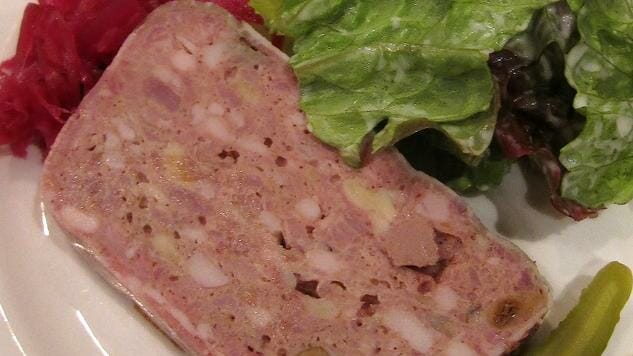Second Look: Pâté
Photos courtesy of Wikipedia
I grew up in New York City, where pâté came in a fancy jar from Payard or on a plate from Balthazar, if it was served at all. But I’m marrying into a French country family; my future mother-in-law, Claudine Chenuet, grew up in a family of 14, where whole hogs were regularly butchered in the courtyard, and every last scrap was emulsified with fat into true, country-style pâté.
While Claudine didn’t inherit her parents’ recipe, she did start making pâté at home over 10 years ago, when her husband’s uncle, a cook by trade and a hunter by passion, gave her his secret recipe. The tradition nevertheless appears to be sputtering in France nearly as quickly as it’s picking up in the US.
Kathryn Tomajan of Local Butcher Shop in Berkeley says that their pâté and terrine classes regularly sell out. “Once they take a class, we find students excited to try it at home,” says butcher Sam Ramirez. “They ask a lot of questions about sourcing offal, fat, heads, and other things that go into the pâtés.”
Shelley Wiseman of The Farm Cooking School in New Jersey says that their pâté course is quite popular as well. “People are apprehensive,” she says. “And they generally find it easier than they expected.”
But there’s no need to go the route of an organized class. Hannah Kirshner, of the blog Sweets & Bitters, began making chicken liver pâté at home eight years ago on her own. “It was much easier than I expected,” she says. “After the first time, I didn’t need a recipe.”
Indeed, chicken liver is a popular first-time pâté, according to Camas Davis of the Portland Meat Collective, who calls it the “gateway drug” of pâté making. Most recipes call for very little liver as compared to butter, cream, or cream cheese – often half as much – which makes this a palatable first attempt.
“It’s actually quite delicious and mild, and then (people) move from there into terrines and pâtés,” says Camas.
Julie H. Case also started with liver pâté. While the recipe was more complicated than she had expected, she soon got the hang of it.
“It has since become quite easy for me, although I admit that sometimes my pâtés are, well, let’s call them low-country pâtés,” says Julie. “Maybe I should be glad that pâté has such a reputation for being difficult to make. It lets me impress people.”
But chicken liver as a gateway pâté seems a bit backwards when you consider both the general American aversion to offal and the fact that most pâtés, from rillettes to country-style terrines, actually contain little to no offal at all.
Claudine says that she has never used offal in her pâté. “I’ve got a liver someone gave to me in my freezer,” she says. “They told me to either mix it with the muscle meat or just make a liver pâté. But I haven’t tried it yet.”
-

-

-

-

-

-

-

-

-

-

-

-

-

-

-

-

-

-

-

-

-

-

-

-

-

-

-

-

-

-

-

-

-

-

-

-

-

-

-

-








































